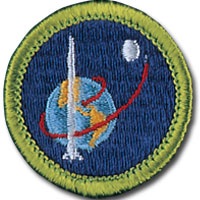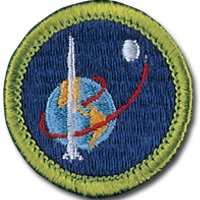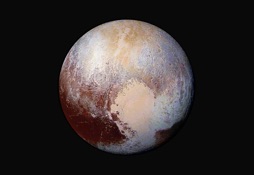Space Exploration
Merit Badge - Pluto






Space Exploration Merit Badge Supplementals
(created Mon., Jan. 16, 2017, updated Good Friday April 19, 2019)
This is an extension of
the Space Exploration Merit Badge page.

PLUTO
♇
This page provides insights about Pluto.
The information on this page is NOT required for the Space Exploration Merit Badge.
The information on this page is shared to provide additional insights into the exploration of Pluto and to encourage enthusiasm about all that is exciting about the exploring the universe beyond our planet, in person and through unmanned spacecraft.

Pluto...
-
-Our ninth planet, discovered in 1930, ...
-
-“demoted” in 2006,
(through what appears to have been a personal dislike for Clyde Tombaugh) ... -
-and now properly recognized as a third category of planets...
-
-1) rocky planets like the inner planets Mercury, Venus, Earth and Mars
-
-2) gas giants like Jupiter, Saturn, Uranus and Neptune
and -
-3) dwarf planets like Pluto and Eris, which are smaller and likely far outnumber all other planet types.
-
-Yes, there are different kinds / types of planets, just like there are different kinds / types of stars... with their own wide variety of sizes, colors, temperatures, etc.
-
-has been visited by NASA’s New Horizons spacecraft.
This group of pages is dedicated to sharing all the interest and excitement of what it took to learn what we now know about Pluto... knowledge gained by the strong dedication and commitment of the New Horizons mission team and all who supported them in their efforts.

This specific page has four sections:
-
1.Planet definition, from Merriam-Webster dictionary
-
2.Brief history of planetary discoveries
-
3.Kuiper Belt objects (KBOs), Oort Cloud, IAU Planet definition refinement and Pluto’s demotion
-
4.“An organically grown planet definition,” as published in Astronomy magazine by New Horizons Principal Investigator Alan Stern

1. Planet, the definition:
noun | plan·et | \ˈpla-nət\
Definition of PLANET
a : any of the seven celestial bodies sun, moon, Venus Jupiter, Mars Mercury, and Saturn that in ancient belief have motions of their own among the fixed stars.
b (1) : any of the large bodies that revolve around the sun in the solar system (2) : a similar body associated with another star
source: https://www.merriam-webster.com/dictionary/planet
Later on that page, Merriam-Webster goes on to provide the following:
“Did You Know?
“Planet goes back to ancient Greek planēt- (literally, "wanderer"), which is derived from "planasthai," a Greek verb which means "to wander." The name "planet" was originally applied to any of seven visible celestial bodies which appeared to move independently of the fixed stars - the sun, the moon, Mercury, Venus, Mars, Jupiter, and Saturn. In the 17th century, "planet" began to be used specifically of the rocky or gaseous bodies that orbit around the sun - a definition which excluded the moon and, obviously, the sun, but included the Earth and, as they were discovered, Uranus, Neptune, and Pluto. In 2006, the International Astronomical Union developed a narrower definition of "planet," effectively demoting Pluto to the status of a "dwarf planet," a celestial body that is spherical and orbits the sun but is not large enough to disturb other objects from its orbit.”

2. Brief history of planetary discoveries
The originally-known planets...
From the dawn of history five other planets were known beyond Earth, for six total:
-
1.Mercury
-
2.Venus
-
3.Mars
-
4.Jupiter
-
5.Saturn

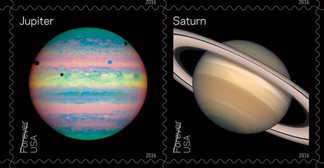
image source: https://www.nasa.gov/sites/default/files/thumbnails/image/14-0_usps16sta023h.jpg
Uranus...
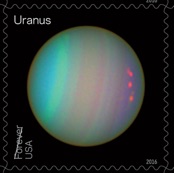
image source: https://www.nasa.gov/sites/default/files/thumbnails/image/14-0_usps16sta023h.jpg
In 1781, William Herschel, who, ...
-
-had a strong background in classical music,
-
-had built his own 40-foot long (12 meter) telescope, the largest in its day,
-
-with his sister Caroline
(a great scientist herself... the first woman to discover a comet (discovered eight total), who discovered several deep-sky objects on her own, and the first woman in a paid position and to also receive an honorary membership in the Royal Society),
conducted a survey of the night sky -
-was surveying the night sky and noticed something move...
-
-... making Herschel was the first to confirm that this was a planet... Uranus
Uranus was the first planet discovered by a telescope.
We then knew of six other planets were known beyond Earth, for seven total.
This date in science: Uranus discovered, completely by accident
By EarthSky in SPACE | March 13, 2015
“William Herschel noticed while surveying stars that one object moved apart from the star background. It was the first planet discovered since ancient times.”
http://earthsky.org/space/this-date-in-science-uranus-discovered-completely-by-accident
Neptune...
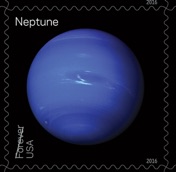
image source: https://www.nasa.gov/sites/default/files/thumbnails/image/14-0_usps16sta023h.jpg
Then, in 1846...
While we now think Galileo first discovered Neptune ~ 1613, it was in 1846 that
“Johann Gottfried Galle using calculations by Urbain Le Verrier and John Couch Adams, making it a joint British-French-German discovery.”
source: http://www.space.com/26972-neptune-planet-discovery-skywatching.html
See also: http://www.universetoday.com/21621/who-discovered-neptune/
We then knew of seven other planets were known beyond Earth, for eight total.
Pluto...
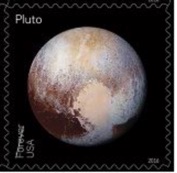
image source: https://about.usps.com/postal-bulletin/2016/pb22442/html/images/kit_2.jpg
Then, in Arizona in January and February, 1930...
“Boston-born astronomer Percival Lowell initiated the search for a planet beyond Neptune in 1905, a year before the birth of the person who eventually found it, Clyde Tombaugh. Tombaugh discovered Pluto on photographic plates taken in 1930 at Lowell Observatory in Flagstaff, Arizona. Yet it was so far away, small, and faint - 41 times Earth’s distance from the Sun, less than 0.1 arcsecond in diameter, and magnitude 15.1 - that it was beyond the technology of the times to learn much about it.”
source: “Pluto - Up close and personal,” Astronomy Magazine; July, 2015.
This picture of Clyde Tombaugh is from the July, 2015 issue of Astronomy magazine.
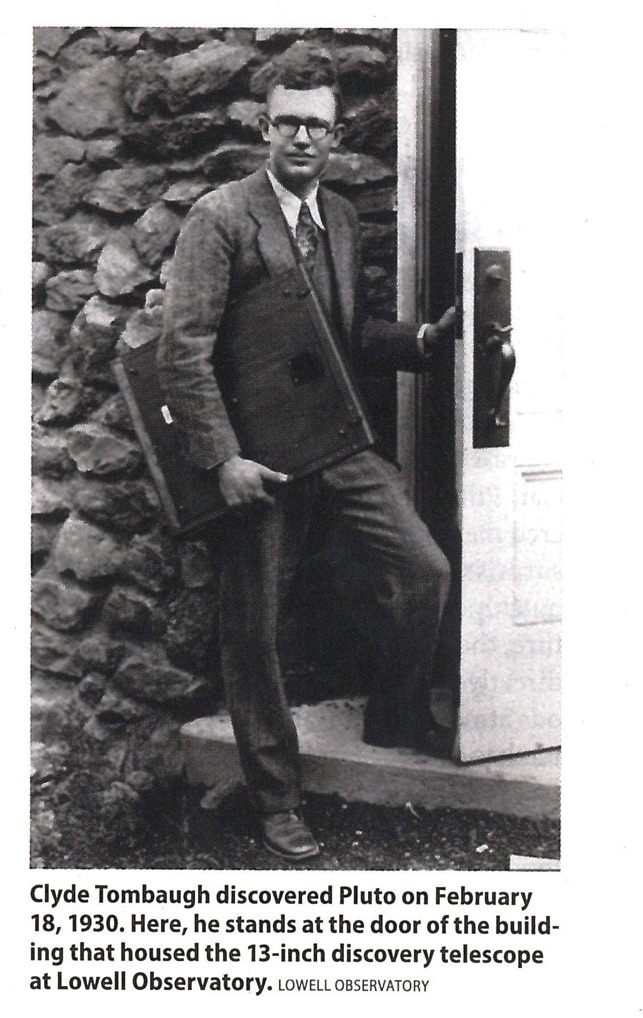
... Pluto was first seen by comparing two images showing
its movement from one week to the next...
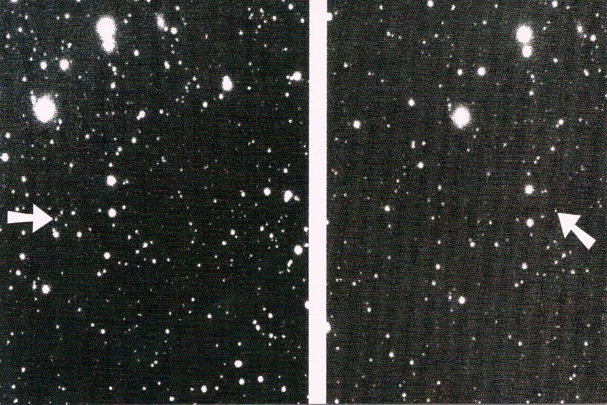
... as photographed in the 13” Pluto Discovery Telescope, by Clyde Tombaugh...
image source: digital scan of a postcard purchased at the Lowell Observatory
... Pluto was first seen via the naked-eye in the 24” (refractor) Clark Telescope, at Lowell Observatory, named for the astronomer who predicted Pluto’s existence - Percival Lowell, in Flagstaff, Arizona.
Learn more in “The Discovery of Pluto.”

3. Kuiper Belt Objects, Oort Cloud, IAU Planet definition refinement and Pluto’s demotion
The four inner planets - Mercury, Venus, Earth & Mars - are also called terrestrial planets, or rocky planets, because of their similar size and the fact that they have clearly visible surfaces.
The four larger outer planets - Jupiter, Saturn, Uranus, and Neptune - are called gas giants because they are incredibly large balls of gas with no confirmed surface (thought space probes will continue to determine whether there is a surface inside them).
Pluto is clearly different from the group,
-
-smaller than all other planets
-
-eccentric orbit
-
-etc.
Pluto is not just smaller than Earth, but also smaller than our moon:
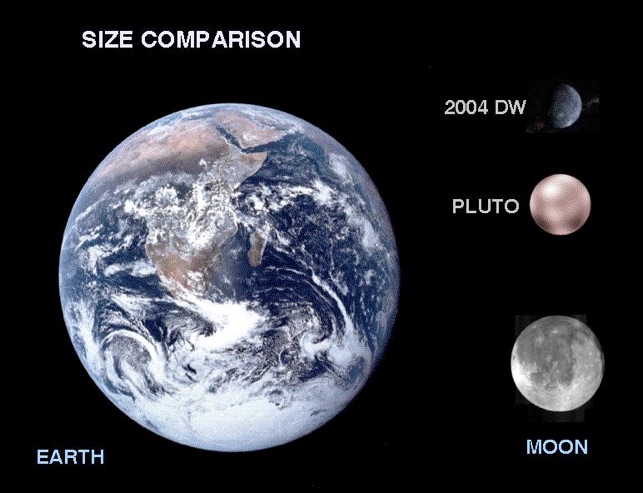
source: http://www.boskowan.com/www/jirka/vesmir/planets/pluto/pluto%20size.jpg
The New Horizons flyby also confirmed...
“How Big Is Pluto? New Horizons Settles Decades-Long Debate
“NASA’s New Horizons mission has answered one of the most basic questions about Pluto—its size.
“Mission scientists have found Pluto to be 1,473 miles (2,370 kilometers) in diameter, somewhat larger than many prior estimates. Images acquired with the Long Range Reconnaissance Imager (LORRI) were used to make this determination. This result confirms what was already suspected: Pluto is larger than all other known solar system objects beyond the orbit of Neptune.
“The size of Pluto has been debated since its discovery in 1930. We are excited to finally lay this question to rest,” said mission scientist Bill McKinnon, Washington University, St. Louis.
“Pluto’s newly estimated size means that its density is slightly lower than previously thought, and the fraction of ice in its interior is slightly higher. Also, the lowest layer of Pluto’s atmosphere, called the troposphere, is shallower than previously believed.
“Measuring Pluto’s size has been a decades-long challenge due to complicating factors from its atmosphere. Its largest moon Charon lacks a substantial atmosphere, and its diameter was easier to determine using ground-based telescopes. New Horizons observations of Charon confirm previous estimates of 751 miles (1208 km) kilometers) across.”
source: https://www.nasa.gov/feature/how-big-is-pluto-new-horizons-settles-decades-long-debate
Kuiper Belt Objects (KBOs)
“...mid-20th-century planetary science giant Gerard Kuiper, following on ideas [Frederick] Leonard and [Kenneth] Edgeward had pioneered, made a convincing case in 1950 that Pluto might be the brightest of a vast cohort of similar planets and smaller bodies orbiting in the “trans-Neptunian region.”
“All that changed in 1992 when University of Hawaii astronomers David Jewitt and Jane Luu discovered an object called 1992 QB, the first sighted partner to Pluto orbiting beyond Neptune. Although scientists estimated it to be 10 to 30 times smaller than Pluto’s 1,485 mile (2,390 kilometer) diameter, QB unleashed a torrent of discoveries almost immediately. In 1993, observers found four more such objects. In 1994, 10 more turned up. By the late 1990s, researchers had discovered almost 1,000 bodies. luto’s context was now clear: It was not a misfit; it simply had been the first and brightest of a vast population of solid bodies ranging from roughly 60 to more than 600 miles (100 to over 1,000 km) across orbiting beyond Neptune.
“This powerful discovery led to a fundamental redrawing of our map of the solar system, adding a third zone beyond the terrestrial and gas giants - the so-called Kuiper belt.”
source: “Pluto - Up close and personal,” Astronomy Magazine; July, 2015.
Oort Cloud
In the early 2000s, further discoveries helped us realize more about our solar system.
“Sedna is a solar system body that is one of the most distant bodies found in our solar system. The object's closest approach to the sun is far greater than Pluto's distance away from Earth — at a spot where the sun is so tiny, according to NASA, that you could blot it out with a pin.
“Sedna was discovered by a team led by Mike Brown, an astronomer at the California Institute of Technology. The discovery of Sedna and other objects similar to it was a large impetus behind demoting Pluto from planetary status in 2006.
“Brown's team found Sedna in 2003 as part of a larger survey of the solar system that began in 2001. Using the Samuel Oschin Telescope at the Palomar Observatory (east of San Diego) as well as Palomar's QUEST camera, the astronomers would take pictures of a tiny spot in the sky — one per hour for three hours — and see if they could find something that moved, Brown said in an explanation page about the discovery.
"The many billions of stars and galaxies visible in the sky appear stationary, while satellites, planets, asteroids, and comets appear to move. Objects in the inner Oort Cloud are extremely distant and so move extremely slowly," he said.
The Oort Cloud is a theorized area far in the solar system that is supposed to contain billions of icy objects that, if they receive a gravitational push toward the sun and warm up, turn into comets as the sun's energy melts the ice. Sedna, however, was much bigger than a comet. Estimates for Sedna's size vary, but it is believed to be slightly smaller than the size of Pluto (1,400 miles or 2,250 kilometers in diameter).[Related: New Horizons' Pluto Flyby: Latest News, Images and Video]”
source: http://www.space.com/25695-sedna-dwarf-planet.html
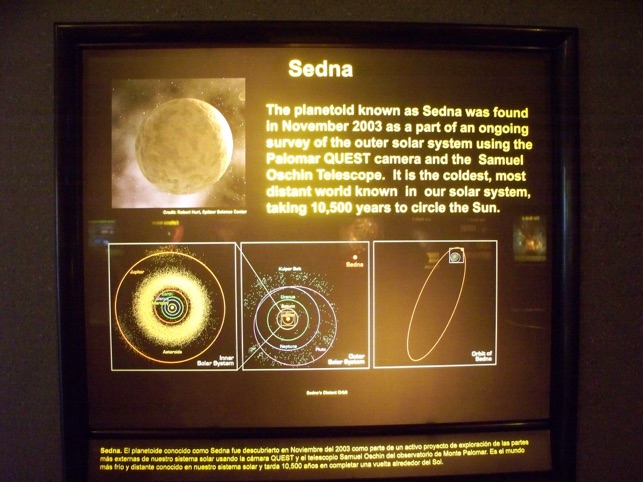
image source: personal photo captured at the Palomar Observatory
This InfoGraphic from the July, 2015 issue of Astronomy magazine shows the largest objects found beyond Neptune.
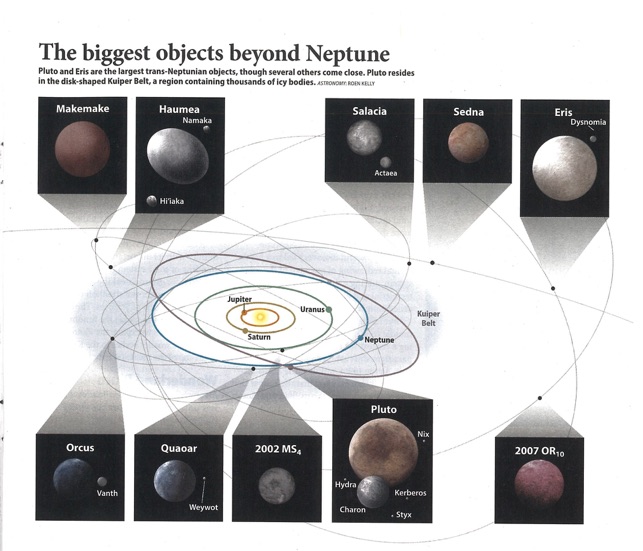
IAU Planet definition refinement and Pluto’s demotion
“On Aug. 24, 2006, Pluto — which had been known as the ninth planet since its 1930 discovery — was demoted to the newly created category of ‘dwarf planet.’
“In 2006, the IAU came up with the following official definition of "planet": A body that circles the sun without being some other object's satellite, is large enough to be rounded by its own gravity (but not so big that it begins to undergo nuclear fusion, like a star) and has "cleared its neighborhood" of most other orbiting bodies.
“Since Pluto shares the Kuiper Belt with lots of other big objects, it failed to meet the third criterion and didn't make the cut. Instead, the IAU rebranded Pluto and Eris as "dwarf planets." [Meet the Solar System's Dwarf Planets]
source: http://www.space.com/12709-pluto-dwarf-planet-decision-5-years-anniversary-iau.html
And, thus, textbooks were rewritten, and parents were challenged explaining the solar system to their children, unable to properly list the names of the nine planets, etc.
But... it is interesting to note that...
“Other scientists, however, aren't at all happy with the IAU's planet definition, calling it flawed and unscientific.
"I think the IAU really embarrassed themselves with this," said Alan Stern of the Southwest Research Institute in Boulder, Colo. Stern leads NASA's New Horizons mission, which is sending a spacecraft to study Pluto up close. "They created a problem for themselves and for astronomy. It [the definition] created an unworkable algorithm for deciding what's a planet and what's not." [Cosmic Definitions: What Is a Planet?]
“Stern particularly objects to the "clearing your neighborhood" criterion.
"In no other branch of science am I familiar with something that absurd," Stern told SPACE.com. "A river is a river, independent of whether there are other rivers nearby. In science, we call things what they are based on their attributes, not what they're next to."
“Further, Stern said, the criterion sets different standards for planethood at different distances from the sun. That's because the farther away a planet is from the sun, the bigger it needs to be to clear its zone. If Earth circled the sun in Pluto's orbit, for example, it wouldn't qualify for planethood in the IAU's eyes.
"I would say any definition that produces a result where Earth is not a planet under any circumstance is immediately indicted as ridiculous, because one thing we all agree is a planet is planet Earth," Stern said.
“Stern doesn't have a problem with the term "dwarf planet." He just thinks dwarfs should be deemed "true" planets like the terrestrial planets and gas giants. Excluding the dwarfs from the official list amounts to an effort to keep the number of planets down to a manageable size, Stern added.
"That's not a very scientific way of going about it, since we have countless numbers of stars, galaxies, asteroids and everything else," Stern said.”
source: http://www.space.com/12709-pluto-dwarf-planet-decision-5-years-anniversary-iau.html
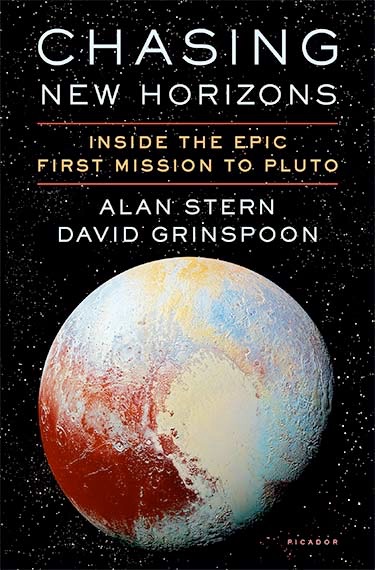
Alan Stern, Principal Investigator on the New Horizons mission, wrote a very good book about the effort from the late 1980s until the 2015 Pluto flyby, called “Chasing New Horizons.”
With respect to Pluto’s planetary status and the IAU’s 2006 vote, he shared (pp. 272-173):
“Back in 1980 a British astronomer named Brian Marsden had famously told Clyde Tombaugh that Pluto wasn’t a planet in his view, and that it would be his mission to erase Tombaugh’s legacy by having Pluto re-classified as an asteroid. No one we’ve asked remembers why Marsden felt so strongly about this, but people did report that, for some reason, Marsden didn’t like Tombaugh. Then, at the 2006 IAU meeting, a gaggle of astronomers led by Marsden procedurally objected to the IAU committee’s newly proposed planet definition.”

4. “An organically grown planet definition”
by Kirby D. Runyan and S. Alan Stern
As published by Astronomy Magazine Thursday, May 17, 2018
In a fantastic two-page article in the May, 2018 issue of Astronomy Magazine, Kirby D. Runyan and S. Alan Stern propose a definition of planet that allows for multiple kinds of planets, just like there are different classes of elements in the periodic table of, and as there are different types of stars and galaxies.
I personally think this approach is exactly right. I am thankful for their insights and for Astronomy for having published their article.
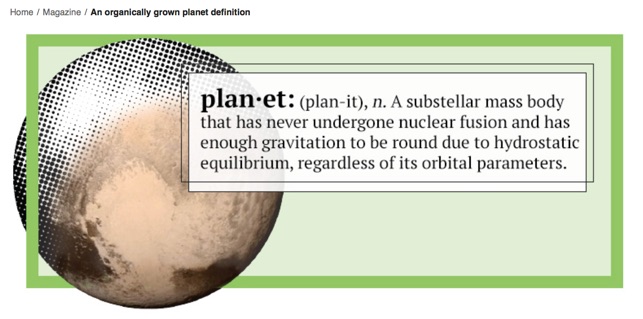
source: Astronomy.com
What do you think?
You can read the article hear and make your own conclusion about whether this is or is not a good approach to defining objects that we call planets. - “An organically grown planet definition.”
I am also thankful that Astronomy Magazine published in their September, 2018 issue, my Letter to the Editor lauding the article by Runyan and Stern.:




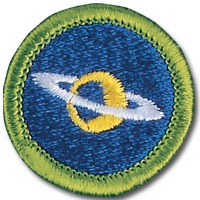
These are all of the links to the Astronomy Merit Badge pages:
Astronomy Merit Badge - Extra “Fun Facts”
Astronomy - Great American Eclipse
Astronomy - Great American Eclipse 2017

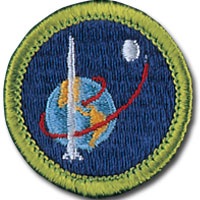
These are all of the links to the Space Exploration Merit Badge pages:
New Horizons - Mission Overview
New Horizons - Pluto Resources


All images were scanned directly from the magazine using the Halo Scanner Mouse - http://shop.halo2cloud.com/collections/computer-and-backup/products/scanner-mouse, which I received as a Christmas present from my mother in 2013.



Regardless your desire to pursue a career in space exploration, it is hoped that you learned enough about exploring space through this merit badge to at least be interested to continuously look up at the sky in awe and wonder, and think about what you may want to explore if you were to go “out there” or were to send a probe “out there.”
If you pursue with enthusiastic interest, that’s great. If you do make a career in the field, GREAT.
May all be better off having completed your Space Exploration Merit Badge than you were before you started.
